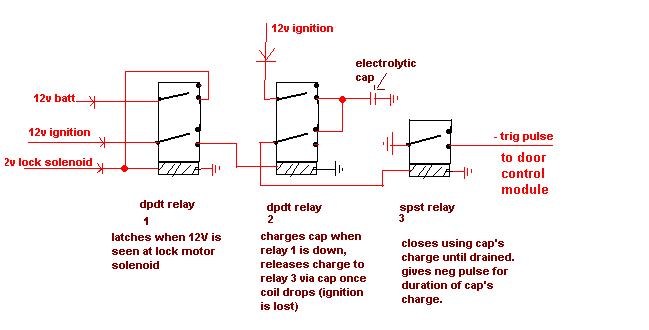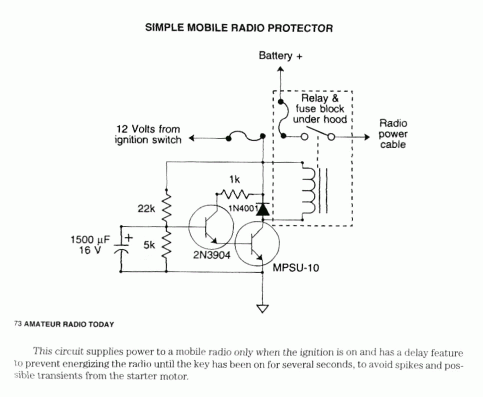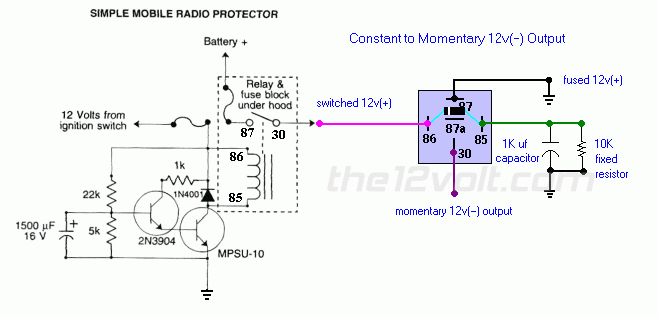hi all:
Thanks for keeping this board running. there is a huge amount of great info in here.
I have searched through many posts and relay diagrams, but I've not yet found something that will do precisely the following. The problem is that my car auto-locks all doors, but does not auto unlock the passenger door., only the driver's. There is no way around this using the car's programming. This was changed by the manufacturer in the next year's model.
GOAL: send a 12V - pulse to the "unlock all doors" wire in my door once ignition is killed. I tested this and grounding this wire will unlock both doors.
I have access to connections for 12v batt, 12V ignition, driver's doorlock motor, and ground in my driver's door now. I'd like to put this device into the driver's door itself.
I need to 'approve' this auto-unlock process by getting either 1) Ignition for at least 30 seconds or 2) 12V from the driver's door having been locked electronically. Once "approved", meaning the driver's door has been locked by the car (At 15km/hr), or if ignition has been seen for at least 30 secs, .. then as soon as ignition is removed, send the pulse just once.
there it is.. any help would be most appreciated!
Thanks
J.
I'm replying to my own email to mention that I'm ok to use a DPDT relay to latch itself once it sees the driver's doorlock motor activate (goes 12v+ momentarily).. so that will handle the "approval" or "ok to auto-unlock doors later" phase...
next part is to give the 12v- pulse I seek, once ignition is removed.
thanks again all for any input (and 12- output) you can offer :)
J.

how's this look? it came to me this morning.. should be able to rebuild using transistors though - this is silly to use relays for a low-current circuit like this.. any suggestions/improvements/things I've missed?
thanks!

-------------
John DeRosa (Hotwaterwizard)
Stockton California
When in doubt, try it out !
Add that Circuit with a Constant to momentary and you got it. Circuit modified for negitive pulse output.

-------------
John DeRosa (Hotwaterwizard)
Stockton California
When in doubt, try it out !
wow Hotwaterwizard.. thank you. I appreciate the help!
Looking this over though... the first 1/2 of this circuit (radio protector) would handle the delay portion, and would send 12v + to the 2nd portion after a few seconds of ignition being on; that part is cool. (And adjustable using different resistors and caps to extend that delay). So far so good...
but then, the 2nd portion of the circuit (constant to momentary) would pulse a negative briefly to the door unlock portion as I see it, as soon as that delay had expired.
this would mean that after a few seconds of seeing ignition, the system would UNLOCK the doors, rather than waiting to LOSE ignition.
What has to happen here, is that that negative pulse is only to appear once, and briefly , once that 12V is LOST. Have I mis-read something?
Thanks again!
Power-Off Time Delay Relay https://ourworld.compuserve.com/homepages/Bill_Bowden/page2.htm
The two circuits below illustrate opening a relay contact a short time after the ignition or ligh switch is turned off. The capacitor is charged and the relay is closed when the voltage at the diode anode rises to +12 volts. The circuit on the left is a common collector or emitter follower and has the advantage of one less part since a resistor is not needed in series with the transistor base. However the voltage across the relay coil will be two diode drops less than the supply voltage, or about 11 volts for a 12.5 volt input. The common emitter configuration on the right offers the advantage of the full supply voltage across the load for most of the delay time, which makes the relay pull-in and drop-out voltages less of a concern but requires an extra resistor in series with transistor base. The common emitter (circuit on the right) is the better circuit since the series base resistor can be selected to obtain the desired delay time whereas the capacitor must be selected for the common collector (or an additional resistor used in parallel with the capacitor). The time delay for the common emitter will be approximately 3 time constants or 3*R*C. The capacitor/resistor values can be worked out from the relay coil current and transistor gain. For example a 120 ohm relay coil will draw 100 mA at 12 volts and assumming a transistor gain of 30, the base current will be 100/30 = 3 mA. The voltage across the resistor will be the supply voltage minus two diode drops or 12-1.4 = 10.6. The resistor value will be the voltage/current = 10.6/0.003 = 3533 or about 3.6K. The capacitor value for a 15 second delay will be 15/3R = 1327 uF. We can use a standard 1000 uF capacitor and increase the resistor proportionally to get 15 seconds.

https://ourworld.compuserve.com/homepages/Bill_Bowden/relay_i.gif
-------------
John DeRosa (Hotwaterwizard)
Stockton California
When in doubt, try it out !
The circuit would look something like this.
Delay off with Pulse timer to follow
-------------
John DeRosa (Hotwaterwizard)
Stockton California
When in doubt, try it out !
Looks great. thank you so much once again for your help , hotwaterwizard!



